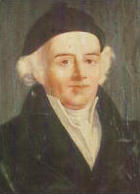-
Homöopathie
-

The founder of Homeopathy is the doctor and professor Samuel Hahneman. He lived from 1755-1843. Hahnemann’s foundational theory is found in the phrase “Sinüla similibus curentur”, meaning “Likes are cured with likes.” He discovered that the poison of a substance that brings about the same symptoms in a sick person can also be used to cure the disease.
The basis of Homeopathic therapy with humans and animals is the consideration of the entirety of active symptoms, not just observation based on previously diagnosed conditions. However, this does not mean that a clinical diagnosis is irrelevant. The homeopathic therapist takes previous diagnoses into account but remains flexible with his observations of the patient in order to detect symptoms previously overlooked or deemed unrelated. This is done because the proper medicine can only be given with all symptoms taken into account.
These symptoms are of various types: they concern the individual characteristics of the animal, its behaviour, as well as sudden changes within its behaviour. Aside from these symptoms, the medical history is also important. This means that in the use of Homeopathy in veterinary medicine, the owner of the animal should be capable of keen observation. However, the homeopath may find symptoms the owner had overlooked due to his being used to the behaviour of the animal. Cooperation between owner and homeopathic therapist in observation can make finding the right medicine much easier.
Homeopathy is a method of healing that strengthens the ability of the body to heal itself. It supports the organism in it’s natural course of beginning and being in control of the healing process. Symptoms therefore are not the same as those in medical school. Through the use of chemical medicine i.e. Cortizone, Antibiotics, or Anabolics we achieve repression. After treatment with such medicines, symptoms may temporarily disappear, but this doesn’t last long - not to mention the often dangerous side effects.
Healing is only possible by attacking the cause, not by treating the symptoms. Sickness is a form of defence - an attempt to regain balance within the body. The idea is to strengthen and support this process and not to interfere with it. The choice of medicine has to be appropriate for the organism, or else it will not react well with it, yielding no results. Of course, homeopathy has its limits. It is a therapy that stimulates and supports. Homeopathy can not help an organism that can no longer be stimulated or enticed to heal itself.
-
Homeopathic Resources
-

Homeopathic medicine uses plants, animals, and minerals as starting material. Next, a tincture is created which is either thinned out using alcohol, or mixed with lactose in the case of insoluble output material. The dilution process, called potentisation, follows a step by step guideline with set rules. In order to choose a homeopathic medicine, its potency, and its make up, careful observation and diagnosis has to occur.
-
Areas of Application
-
- Acute and chronic sickness in mammals
- Diseases of the airway
- Diseases of the eyes
- Diseases of the skin
- Diseases of the muscular and skeletal systems
- Diseases of the heart and circulatory system
- Diseases in the digestive system
- Disease within the kidneys, bladder, and liver
- Diseases within the throat and hull
- Lameness in the the front and hind limbs
- Behavioural disorders



